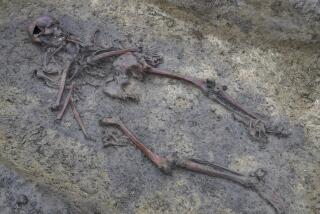In Amsterdam, Researchers Play Detectives in Effort to Find Rembrandt’s Remains
- Share via
AMSTERDAM — Anatomical researchers have set out to find the remains of the master painter Rembrandt under the floor of an old church.
The impetus for the search came late in October when workers restoring the 17th-Century Western Church in Amsterdam turned up the skeletal remains of people buried under the church, as was the custom until the mid 1800s.
The Dutch Master died in 1669 at the age of 63 and was buried in the church, Amsterdam’s first Protestant house of worship.
But exactly where, no one knows, since the financially beleaguered artist’s family could only afford a place in one of the multiple graves for less well-off congregants, and those carry no names.
To do the detective work, the church contacted Leiden University’s Anatomical Laboratory, the Netherlands’ preeminent research institution for physical anthropology and physiology.
But university researchers play down the chances of ever identifying Rembrandt’s remains after more than three centuries.
“One of the problems with the church people,” observed Willem Mulder, the excavation director, “is the first thing they say if they find any bones is ‘That must be Rembrandt!’ ”
In coming months, the Leiden specialists will analyze the contents of the flagstone-covered graves that cover the 14,500-square-foot church interior.
They agreed to take on the job as part of their research into Dutch growth patterns and diseases in past centuries.
“However interesting Rembrandt’s remains may seem to be, scientifically it is much more important to see how many men and women you can find and if they’ve got any pathological defects,” Mulder, curator of the Leiden lab’s Anatomical Museum, said in an interview.
The church elders consider it a fair exchange if they get a line on where the Dutch Master’s remains lie.
“If we can find him we can rebury him in a special grave,” said the restoration’s fund-raising chairman, Philip Korthals-Altes, “so that all visitors in the future who come to see the Western Church can see the place where Rembrandt was buried.”
“It would be a sobering experience to find them, and it would be a triumph,” agreed Ernst van der Wetering, a Rembrandt scholar.
“It’s part of the legend of the misunderstood or the poor artist, sort of shoveled away.”
One possible clue to Rembrandt’s remains would be the detection of excessive lead buildup in the bones, since painters in Rembrandt’s time absorbed large amounts of lead from their paints.
But even Van der Wetering also holds out little hope of finding Rembrandt’s bones.
“They will never find them because there’s no way to identify them,” the Amsterdam University art history professor said.
“There’s nothing of the history of any diseases he had which could help to identify his remnants. We know nothing about his size. We know nothing about injuries he ever had. We know nothing about his dental records. There is nothing, nothing, so they will never find them.”
It is not known how many people were buried in the church from its 1631 opening until the burial custom was halted for health reasons in the mid-1800s.
The search for Rembrandt is complicated by the old custom of leasing graves for a specific time period, and then digging up the bones when the lease ran out and the grave space was needed for another burial.
For that reason, few of the grave flagstones carried names, and bones removed from them were thrown together in a mass burial site.
More to Read
Sign up for Essential California
The most important California stories and recommendations in your inbox every morning.
You may occasionally receive promotional content from the Los Angeles Times.










